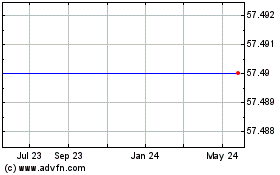New Data from Phase III SATURN Study Showed Tarceva Extended Survival in Patients with Advanced Non-Small Cell Lung Cancer Wh...
02 August 2009 - 3:00AM
Business Wire
OSI Pharmaceuticals, Inc. (NASDAQ: OSIP) today announced further
results from the Phase III SATURN study showing that Tarceva®
(erlotinib) extended the survival of patients with advanced
non-small cell lung cancer (NSCLC) when used as single agent,
maintenance therapy in patients who did not progress following
first-line treatment with platinum-based chemotherapy. As
previously announced, the safety results in this study were
consistent with what has been seen previously and there were no new
or unexpected safety signals. Overall survival was a key secondary
endpoint of the study and these new data were presented today at
the 13th World Conference on Lung Cancer being held in San
Francisco.
“Based on the data presented today, Tarceva is the first oral
cancer therapy to show a survival benefit in the first-line
maintenance NSCLC setting. Assuming approval, when used immediately
after chemotherapy, Tarceva will provide a new, convenient,
non-chemotherapy treatment option for patients - allowing doctors
to continue treating a patient’s disease without exposing them to
the continuous burden and lifestyle constraints of long-term
chemotherapy," stated Gabe Leung, President, Pharmaceutical
Business of OSI Pharmaceuticals.
The study showed that patients with NSCLC treated with Tarceva
had a 23 percent improvement in overall survival compared with
patients who received placebo (hazard ratio=0.81; p-value=0.0088).
The hazard ratio, which assesses risk in the overall trial
population, is widely recognized as the best measure of overall
benefit in large randomized clinical trials. A hazard ratio of less
than one for survival indicates a reduced risk of death. The median
survival (a single point estimate of benefit) for patients
receiving Tarceva was 12 months versus a median survival of 11
months for patients receiving placebo.
The study confirmed that a broad spectrum of patients with
advanced NSCLC experienced a survival benefit from Tarceva.
Specific analysis of patients in the study whose tumors were
confirmed not to have genetic mutations in their epidermal growth
factor receptor (EGFR “wild-type”) showed that this group
experienced a 30 percent improvement in survival (hazard ratio =
0.77; p-value = 0.0243). The majority of patients with NSCLC are
EGFR wild-type. Full data analysis for various sub-groups is still
on-going. However, available data also showed that the hazard ratio
for overall survival in patients with tumors expressing the EGFR
gene by Immunohistochemistry (IHC) was also 0.77 (p-value =
0.0063).
As presented previously, the hazard ratio for progression-free
survival (the time patients live without their disease worsening)
in patients with EGFR mutations was 0.10 (p-value
Osi Pharmaceuticals (NASDAQ:OSIP)
Historical Stock Chart
From Jun 2024 to Jul 2024

Osi Pharmaceuticals (NASDAQ:OSIP)
Historical Stock Chart
From Jul 2023 to Jul 2024

Real-Time news about Osi Pharmaceuticals Inc. (MM) (NASDAQ): 0 recent articles
More OSI Pharmaceuticals, Inc. News Articles